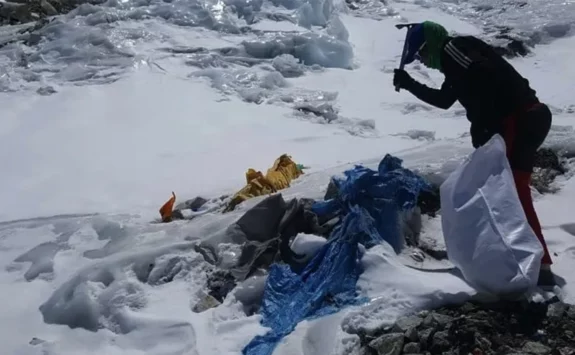Everest Climbers To Adopt Poo Bags for Cleanup
There is growing concern regarding the increasing problem of human waste left behind by climbers on Mount Everest. This waste harms the environment and can also contribute to the spread of diseases. As a response, authorities in Nepal have implemented a new rule for Everest climbers to adopt poo bags for cleanup. These bags are to be used to collect their waste, which climbers are responsible for bringing back down the mountain for proper disposal.
Mingma Sherpa, the chairman of Pasang Lhamu rural municipality, highlighted the importance of a new rule that seeks to address the issue of unpleasant odours and unsightly sights caused by human waste in the area. Climbers must buy the bags at Everest base camp and undergo inspections upon their return to ensure they have followed the necessary protocols.
Sherpa showed worry about the potential harm to the environment and public health, noting that the freezing temperatures on Everest hamper the natural breakdown of waste. He pointed out reports of climbers falling ill as a result of the unhygienic conditions and emphasized the significance of maintaining the town’s reputation and surroundings.
By implementing this measure, authorities hope to address the problem of climbers using the outdoors as toilets. This behaviour not only affects the environment but also raises concerns about hygiene.
More About Poo Bag Management?
The Sagarmatha Pollution Control Committee has purchased around 8,000 waste bags from the United States. These bags, commonly known as “WAG bags,” are designed for use in wilderness areas to securely collect and transport human waste. These products have a design that makes sure they are resistant to punctures and are also coated with a special powder that helps eliminate unpleasant odours.
The bags will be given out to climbers, sherpas, and support staff who will be coming together in the region this season. Every person will be given two bags, which can be used again and again. The bags are designed to contain compounds that solidify human waste, effectively reducing any foul smells.
Mount Everest’s poop problem
As climbers ascend up the mountain, they come across sections where the snow isn’t plentiful, which means they have to take toilet breaks in the open. South Col, which is 7,906 meters (25,938 feet) high, is used as a base camp before the Everest and Lhotse summit efforts. As Mr. Keck observed, the landscape in this region appears barren, with little ice and snow due to the strong winds. Unfortunately, this has led to the presence of human waste scattered throughout the area.
Guides and porters report that just a tiny number of those who walk to the peak of Mount Everest, which can take several weeks, will bring their rubbish back using biodegradable packaging.
Despite increased clean-up efforts by the Nepali Army, the issue of rubbish remains a significant concern on Everest and other mountains in the area.
How poop bags can solve the problem
Promoting the use of poop bags among climbers can effectively address the environmental and health concerns associated with climbing Mount Everest. These specialized bags were created with extreme caution to ensure that human waste is contained and does not harm the mountain’s fragile ecosystem or water sources.
By implementing this requirement for climbers to carry their waste in these bags, authorities can promote responsible waste management practices and help prevent the spread of diseases among climbers and local communities. In addition, poop bags help with the proper disposal of waste at lower altitudes, ensuring that it can be managed safely and hygienically in designated facilities.
This method follows the ethical principles of ecological responsibility and shows a deep respect for the sacred nature of the Everest region. It also ensures that people follow the regulations established by Nepalese authorities. It provides a practical and efficient solution to address the negative effects of human waste on the world’s highest peak.
© Copyright 2024 Eco-friendly Treks. Website Developed by: AVIVA






